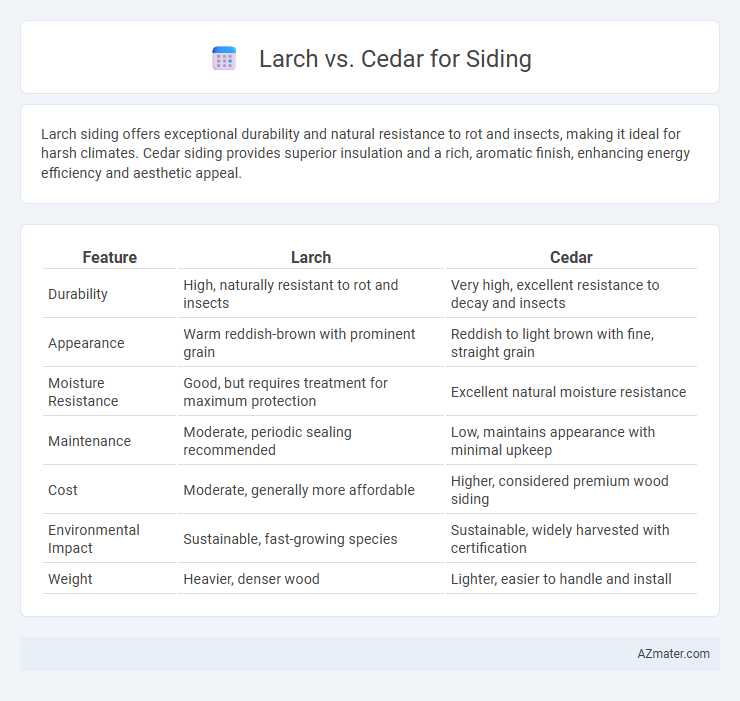Larch siding offers exceptional durability and natural resistance to rot and insects, making it ideal for harsh climates. Cedar siding provides superior insulation and a rich, aromatic finish, enhancing energy efficiency and aesthetic appeal.
Table of Comparison
| Feature | Larch | Cedar |
|---|---|---|
| Durability | High, naturally resistant to rot and insects | Very high, excellent resistance to decay and insects |
| Appearance | Warm reddish-brown with prominent grain | Reddish to light brown with fine, straight grain |
| Moisture Resistance | Good, but requires treatment for maximum protection | Excellent natural moisture resistance |
| Maintenance | Moderate, periodic sealing recommended | Low, maintains appearance with minimal upkeep |
| Cost | Moderate, generally more affordable | Higher, considered premium wood siding |
| Environmental Impact | Sustainable, fast-growing species | Sustainable, widely harvested with certification |
| Weight | Heavier, denser wood | Lighter, easier to handle and install |
Introduction to Larch and Cedar Siding
Larch siding offers exceptional durability and natural resistance to decay, making it ideal for exterior cladding with a distinct warm, reddish-brown hue and prominent grain patterns. Cedar siding provides superior weather resistance and natural insect-repelling properties, featuring a rich amber color and smooth texture that enhances curb appeal. Both larch and cedar are sustainable wood options, valued for their longevity and aesthetic qualities in residential and commercial siding applications.
Appearance and Aesthetic Differences
Larch siding offers a warm, reddish-brown hue with a distinct, straight grain pattern that darkens gracefully over time, providing a natural rustic charm. Cedar siding features a softer, honey-toned color with a fine, uniform texture and aromatic properties, creating a classic, elegant appearance. Both woods improve in character with weathering, but larch tends toward a rugged, bold look while cedar maintains a smoother, refined aesthetic.
Durability and Lifespan Comparison
Larch siding offers greater durability due to its dense grain and high natural resin content, which provides strong resistance to decay and insect damage, often lasting 25 to 40 years with proper maintenance. Cedar siding, known for its natural resistance to rot and insects, typically has a lifespan of 20 to 30 years but may require more frequent treatment to maintain structural integrity. Both woods provide excellent weather resistance, but Larch generally outperforms Cedar in longevity and strength for siding applications.
Natural Resistance to Decay and Insects
Larch wood offers strong natural resistance to decay due to its high resin content, making it a durable choice for siding in moisture-prone environments. Cedar's natural oils provide excellent insect-repellent properties and decay resistance, contributing to its long-lasting performance in exterior applications. Both woods perform well for siding, but cedar's superior insect resistance often makes it preferred in areas with high pest activity.
Climate Suitability for Larch vs Cedar
Larch wood excels in cold, wet climates due to its high natural resin content, providing strong resistance to moisture and decay, making it ideal for harsh weather conditions. Cedar, known for its natural oils and tight grain, offers excellent durability and resistance to rot and insects, particularly in moderate to humid climates. Both woods perform well for siding, but Larch is better suited for extreme cold and wet environments, while Cedar thrives in temperate and coastal regions.
Cost Analysis and Price Comparison
Larch siding typically costs between $6 to $9 per square foot, offering a cost-effective option compared to cedar, which ranges from $7 to $11 per square foot due to its higher durability and aesthetic appeal. Installation expenses for both materials vary, with larch generally requiring less maintenance, reducing long-term costs, while cedar's natural resistance to decay may lower repair expenses. Budget-conscious homeowners should weigh initial material prices against longevity and upkeep when choosing between larch and cedar for siding.
Maintenance Requirements and Longevity
Larch siding offers high natural durability and moderate maintenance, requiring annual sealing or staining to protect against moisture and decay. Cedar siding provides superior resistance to rot and insects, with maintenance involving periodic cleaning and reapplication of protective finishes every 3 to 5 years. Both woods boast long lifespans, with cedar typically lasting up to 30 years and larch siding achieving similar durability when properly maintained.
Environmental Impact and Sustainability
Larch siding is prized for its natural durability and fast growth, resulting in a lower carbon footprint compared to slower-growing cedar. Cedar offers excellent resistance to decay and insects, but its slower growth rate can lead to higher environmental costs due to extended harvesting periods. Choosing Larch supports sustainable forestry practices with quicker regeneration, while cedar's longevity provides long-term resource efficiency when sourced responsibly.
Installation Considerations for Each Wood
Larch siding offers robust resistance to moisture and decay, making installation straightforward in humid climates with minimal treatment requirements. Cedar siding requires careful handling during installation due to its softness and potential for dents, but its natural oils provide excellent rot and insect resistance without extensive chemical treatment. Both woods benefit from proper sealing and maintenance to enhance durability and prevent warping over time.
Final Verdict: Which is Better for Siding?
Larch siding offers superior durability and natural resistance to decay, making it an excellent choice for long-lasting exterior cladding in harsh climates. Cedar siding provides exceptional workability and rich, warm aesthetics with natural oils that resist insects and rot, ideal for homeowners seeking beauty and ease of maintenance. For optimal siding performance, larch suits environments demanding robustness and longevity, while cedar is preferred for its exquisite appearance and moderate durability.

Infographic: Larch vs Cedar for Siding
 azmater.com
azmater.com